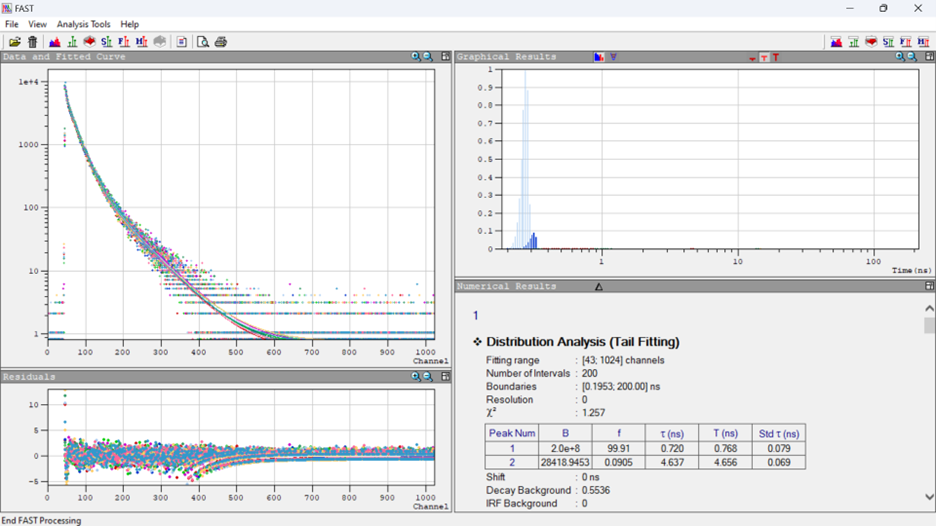
Send us your samples, and we can measure them live in an online demonstration
Contact us to arrange an online demonstration
"*" indicates required fields
FAST (Fluorescence Analysis Software Technology) offers advanced analysis of photoluminescence decay kinetics with outstanding robustness, speed, and fits that are 100% convergent.
FAST contains a library of advanced data reconvolution and curve fitting routines based on proprietary data processing algorithms, which in both speed and reliability surpass the conventional Marquardt-Levenberg algorithm.
Despite the sophisticated and challenging analysis models, FAST is easy to operate, with an intuitive and user-friendly interface. A wide range of data input, on-screen visualisation, and export facilities are available.
Experimental data can be analysed one at a time or in batch mode. The latter is particularly useful for larger data sets such as in assay development and screening.


The Global Analysis Sub-Routine allows one to test decay models for common (linked) lifetime parameters.
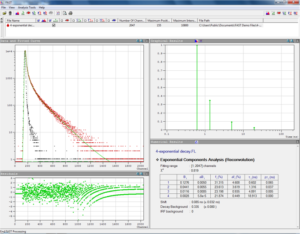
The GLSA (Global Least Square Analysis) algorithm is 100% convergent with either automatic choice of initial values or manual parameter control.
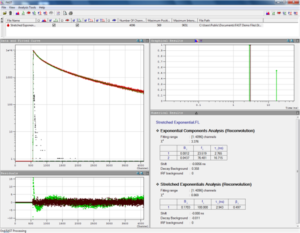
FAST offers the fitting of fluorescence decays with up to four stretched exponential terms (Kohlrausch Quenching Model). Shift and background may be left as fitting parameters, or may be fixed.
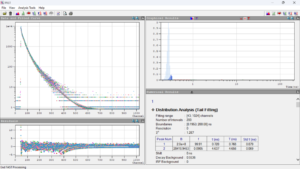
Exponential series method combined with NTSVD (Non-Negative Truncated Singular Value Decomposition) technology. The algorithm does not require predefined shapes of the distributions.

A fitting routine based on GLSA for the analysis of Förster kinetics between donors and randomly (homogeneously) distributed acceptors is included.
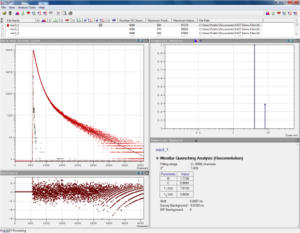
Fluorescence kinetics of Fluorophores embedded in micelles can often be described by the Micellar Quenching model included in FAST.
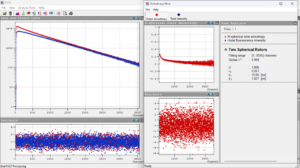
Time-resolved fluorescence anisotropy models include a spherical rotor, two spherical rotors, spherical rotor with restricted rotation and ellipsoidal rotor.
| Advanced Analysis Tools of FAST |
|---|
| Lifetime distribution analysis |
| Exponential component analysis |
| Support plane analysis for the calculation of lifetime confidence intervals |
| Global exponential component analysis |
| Stretched exponential components analysis |
| Förster kinetics analysis |
| Micellar quenching kinetics analysis |
| Analysis of time resolved fluorescence anisotropy kinetics |
| Specifications | Spectral | Phosphorescence Lifetime | Fluorescence Lifetime |
|---|---|---|---|
| Mode of Operation | Single Photon Counting | Time-Resolved Single Photon Counting (Multi Channel Scaling - MCS) | Time-Correlated Single Photon Counting (TCSPC) |
| Lifetime range | Milliseconds to hours | 10 ns - 50 s * | 5 ps - 10 µs * |
| Sensitivity | >35,000:1 ** | n/a | n/a |
| Excitation Sources | |||
| Type | 450 W ozone-free xenon arc lamp | Microsecond flashlamp | Picosecond pulsed diode lasers (EPLs, HPLs) and pulsed LEDs (EPLEDs) |
| Spectral Range | 230 nm- > 1000 nm | 200 nm - >1000 nm | Discrete wavelengths between 250 nm - 980 nm |
| Pulse width | n/a | 1 µs - 2 µs | from 60 ps |
| Options | Ozone generating lamp with spectral range 200 nm - >1000 nm | Low to medium repetition rate pulsed lasers. Variable pulse width VPL and VPLEDs | Nanosecond flashlamp 200 nm - >400 nm pulse width <1 ns |
| * source and detector dependent ** standard water Raman measurement conditions: Excitation wavelength = 350 nm, Excitation and emission bandwidths = 5 nm, step size = 1 nm, integration time = 1 s, emission wavelength = 397 nm, noise measured at 450 nm and calculation based on the SQRT method |
|||
| Monochromator | Specifications |
|---|---|
| Type | Czerny-Turner with 'plug and play' triple grating turret |
| Focal Length | 325 mm (double monochromators: 2 x 325 mm) |
| Stray Light Rejection | 1:10-5 (single), 1:10-10 (double) |
| Gratings | Mounted to triple grating turret |
| Accuracy | +/- 0.2 nm * |
| Minimum Step Size | 0.01 nm * |
| Option | Spectrographs available for operations of CCDs and diode array detectors |
| * grating dependent | |
| Detectors | PMT-900 | PMT-1010 | PMT- 1400/1700 | HS-PMT | MCP-PMT | HS-HPD |
|---|---|---|---|---|---|---|
| Spectral Range | <200 nm - 870 nm | <200 nm - 1010 nm | 500 nm - 1700 nm | <230 nm - 850 nm | <200 nm - 850 nm | 220 nm - 870 nm |
| Dark Count Rate | <50 cps (-20 °C) | <200 cps (-20 °C) | <20 kcps or <200 kps | <150 cps (0 °C) | <10 cps (-20 °C) | <200 cps (10 °C) |
| Reponse Width | 600 ps | 800 ps | 400 ps or 800 ps | 180 ps | <25 ps | 20 ps |
| Options | A wide variety of other photomultipliers and analogue detectors are available up to 5,500 nm | |||||